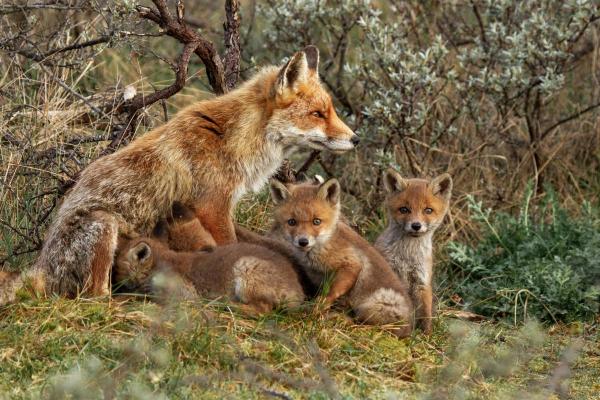
Foxes occupy a unique space in our world. They're wild enough to maintain their mystery, yet adaptable enough to live among us. They star in our oldest folktales as clever tricksters and wise messengers, earning a cultural reputation that's surprisingly consistent across continents and civilizations. These medium-sized members of the dog family have developed specializations and adaptations that make them some of the most successful predators on Earth.
The following article by thedailyECO, we dive into ten remarkable facts about foxes that showcase why these animals have captured both scientific interest and human imagination for centuries.
Foxes exist in 37 species worldwide
When you picture a fox, you're probably thinking of the red fox with its rusty-colored coat and bushy tail. But that's just one of 37 fox species that roam our planet. These canids have conquered nearly every continent except Antarctica.
What's remarkable about foxes is their ability to thrive in such diverse environments. The fennec fox has evolved massive ears that dissipate heat in North African deserts, while the Arctic fox grows a thick white coat to survive temperatures as low as -70°F. Meanwhile, urban foxes have learned to navigate city streets and feast on everything from discarded fast food to garden vegetables.
This incredible adaptability has made foxes one of the most successful carnivore families on Earth, with the red fox holding the title for most widely distributed land predator. Not bad for an animal that typically weighs less than a housecat.

Fox tails make up one-third of their body length
That iconic bushy tail isn't just for show, it's a multi-functional tool that serves several critical purposes in a fox's daily life. At roughly one-third of their total body length, these impressive "brushes" help foxes maintain balance when running and making quick turns during high-speed chases.
In winter, the tail becomes a literal lifesaver. When temperatures drop, foxes curl up and wrap their fluffy tails around their bodies like a built-in blanket, covering their sensitive noses and paw pads to prevent heat loss. Arctic foxes have especially bushy tails for this very reason. In fact, their tails contain more insulating fur per square inch than almost any other part of their body.
Fox tails also serve as important communication tools, with different positions signaling everything from playfulness to aggression. A relaxed, horizontal tail indicates a calm fox, while a raised, bristled tail signals alarm or dominance. For animals that often hunt alone, these visual cues become crucial during brief social interactions.
Red foxes weigh up to 19 pounds
Despite their reputation in folklore and fables, most foxes are surprisingly small animals. The red fox, which is the largest species, typically weighs between 10-19 pounds, which is about the size of a small to medium dog. For comparison, that's significantly smaller than their canid cousins like wolves (80-120 pounds) or coyotes (20-50 pounds).
This modest size actually provides foxes with several advantages. Their relatively light bodies allow them to move quickly and quietly, trotting across fields without disturbing prey. They can also access small burrows and dens that larger predators can't enter, giving them unique hunting opportunities and safe spaces to raise their young.
On the extreme end of the fox size spectrum sits the fennec fox, weighing a mere 2-3 pounds, less than many house cats. These tiny desert specialists are the smallest members of the canid family, with a body adapted for conserving water and staying cool in one of Earth's harshest environments.
Curious about how foxes interact with our feline friends? Discover the surprising truth about these predator-prey dynamics in our revealing companion article.

Foxes have partially retractable claws
Here's something that sets foxes apart from dogs and wolves, they have partially retractable claws. While not as fully retractable as those of cats, fox claws can be withdrawn to a degree that helps keep them sharper longer. This unique adaptation gives foxes greater dexterity when climbing, digging, and handling prey.
Gray foxes (Urocyon cinereoargenteus) take this adaptation even further because they're the only canid species in North America that can climb trees. With their semi-retractable claws and rotating wrists, they can escape predators by scrambling up tree trunks and even leap from branch to branch when necessary. This arboreal skill also gives them access to bird nests and sleeping squirrels that other ground-dwelling predators can't reach.
The climbing ability of gray foxes is a perfect example of convergent evolution, which is the independent development of similar traits in unrelated species. Their tree-climbing skills evolved separately from those of cats, yet serve many of the same purposes, demonstrating how similar environmental pressures can produce similar adaptations in different animal lineages.
Foxes eat both plants and animals
Don't let their carnivore classification fool you, foxes are actually opportunistic omnivores with surprisingly diverse diets. While they certainly enjoy hunting mice, rabbits, and birds, many fox species get up to 30% of their nutrition from plant sources. Berries, fruits, nuts, and even corn frequently appear on the fox menu, particularly during autumn when these foods are abundant.
This dietary flexibility is one of the main reasons foxes have been able to adapt to so many different environments, including your backyard. Urban foxes have become masters at exploiting human food sources, from garden vegetables to discarded takeout. One study in London found that city foxes get almost half their food directly from human sources, showing how quickly these clever canids can adjust their eating habits.
Their omnivorous diet also means foxes play multiple ecological roles because they're simultaneously predators that control rodent populations and seed dispersers that help plants reproduce. After feasting on berries, foxes distribute undigested seeds through their scat, often depositing them in perfect growing conditions with a bit of natural fertilizer included.
Both fox parents raise their young
Unlike many mammals where mothers shoulder the parenting burden alone, fox families are true partnerships. In most fox species, both parents participate actively in raising their kits, with fathers playing an especially important role in food provision and protection.
After the mother gives birth to a litter (typically 4-5 kits), she stays in the den for several weeks, nursing and keeping the blind, helpless newborns warm. During this period, the father works overtime, hunting for his partner and bringing food back to the den. As the kits grow, both parents teach hunting skills, establish territory boundaries, and demonstrate essential survival behaviors.
This shared parenting approach significantly increases survival rates for young foxes, which is a critical advantage in environments where food can be scarce and predators abundant. The family unit typically stays together for about six months, until the young foxes disperse to establish territories of their own in early fall.

Foxes can run 30 mph
Those sleek bodies and long legs aren't just for show, foxes are surprisingly swift, capable of reaching speeds up to 30 mph in short bursts. For context, that's faster than Usain Bolt at his peak, though foxes can only maintain this pace for about a minute before needing to slow down.
Their speed comes with remarkable agility too. Foxes can change direction almost instantly, leaping sideways or making hairpin turns that leave pursuing predators confused. This nimbleness makes them effective hunters of rabbits and rodents, which rely on erratic movements to escape capture.
The aptly named swift fox (Vulpes velox) exemplifies this lightning quickness. These small North American foxes can reach top speeds in just a few bounds, helping them catch grasshoppers and other insects that would elude slower predators. Their acceleration is so rapid that they seem to disappear in a blur of motion, often leading to their nickname of "prairie ghosts."
Foxes make 28 different sounds
The vocal repertoire of foxes is complex and fascinating. Researchers have documented at least 28 different sounds made by red foxes alone, ranging from high-pitched yips to growls, whines, and their famous blood-curdling screams.
The most recognizable fox vocalization is likely the "vixen's scream," a piercing call most commonly heard during mating season. This eerie sound, which has been described as similar to a human scream, serves to attract potential mates and can be heard over considerable distances on still winter nights. Their contact call, a series of short barks that is often mistaken for an owl or other bird.
Foxes use different vocalizations depending on context, warning barks alert family members to danger, while "gekkering" (a rapid series of chattering sounds) typically occurs during play or minor conflicts. These sophisticated communication systems reveal the complex social lives hidden beneath their solitary reputation.

Arctic foxes change color seasonally
Arctic foxes (Vulpes lagopus) undergo one of the most dramatic seasonal transformations of any mammal. During winter, they sport a thick, pure white coat that provides both insulation against temperatures that can drop below -50°F and perfect camouflage against the snow. When summer arrives, they shed this white fur entirely, replacing it with a shorter brown or gray coat that blends with the tundra rocks and vegetation.
This remarkable adaptation, triggered by changing daylight hours, helps Arctic foxes remain nearly invisible to both predators and prey year-round. Their color-changing ability is so effective that researchers often struggle to spot them in the wild, even when they're just a few yards away.
But their winter adaptations go beyond just color. Their fur is the warmest of any mammal, with an insulating value equivalent to the best modern technical fabrics. They even grow fur on the bottoms of their paws, nature's version of snow boots that provide both insulation and traction on icy surfaces.
Fascinated by how foxes adapt to extreme climates? Discover the remarkable web of life at Earth's icy frontiers in our other article.

Foxes control rodent populations
While they might occasionally raid chicken coops, foxes provide a crucial ecological service by controlling rodent populations. A single fox family can consume thousands of mice, voles, and rats annually, helping to prevent agricultural damage and reduce the spread of rodent-borne diseases.
Their hunting efficiency is impressive, a fox can hear a mouse moving under snow from up to 100 feet away, then precisely pounce through the snow to catch it. This "mousing" behavior, where the fox leaps high in the air and dives nose-first into the snow, is both effective and, frankly, adorable to watch.
In areas where fox populations have declined due to hunting or habitat loss, rodent numbers typically surge, often leading to crop damage and increased disease transmission. Several studies have shown that maintaining healthy fox populations can be more effective for rodent control than chemical pesticides, without the environmental side effects.
Did you know that foxes evolved separate hunting strategies from their larger canid relatives? Our detailed comparison of North America's wild dogs reveals exactly how to tell these fascinating predators apart.

If you want to read similar articles to 10 Fun Facts About Foxes You Didn’t Know, we recommend you visit our Facts about animals category.
- Fox cub found alone - Royal Society for the Prevention of Cruelty to Animals. Available at: https://www.rspca.org.uk/adviceandwelfare/wildlife/orphanedanimals/foxcubs
- IUCN (2024). The IUCN Red List of Threatened Species. Available at: https://www.iucnredlist.org